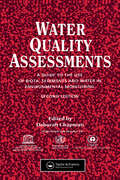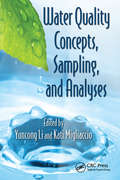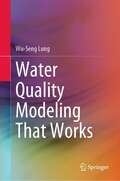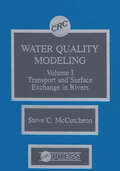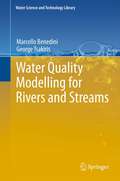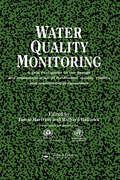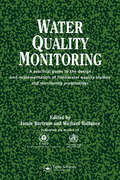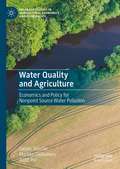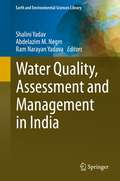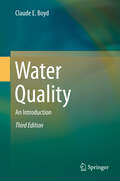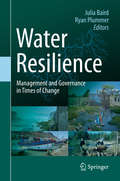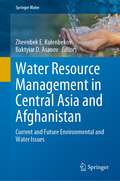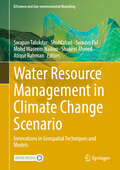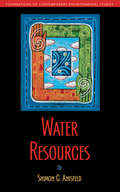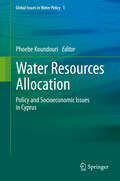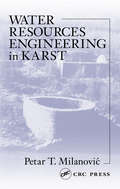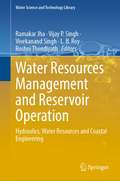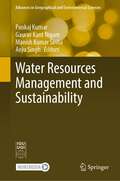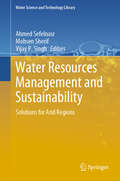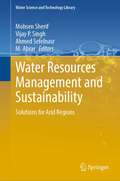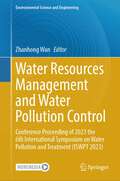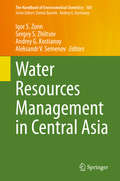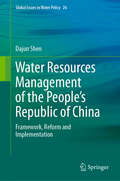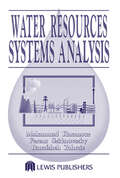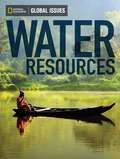- Table View
- List View
Water Quality Assessments: A guide to the use of biota, sediments and water in environmental monitoring, Second Edition
by Deborah ChapmanThis guidebook, now thoroughly updated and revised in its second edition, gives comprehensive advice on the designing and setting up of monitoring programmes for the purpose of providing valid data for water quality assessments in all types of freshwater bodies. It is clearly and concisely written in order to provide the essential information for all agencies and individuals responsible for the water quality.
Water Quality Concepts, Sampling, and Analyses
by Yuncong Li Kati MigliaccioAs water quality becomes a leading concern for people and ecosystems worldwide, it must be properly assessed in order to protect water resources for current and future generations. Water Quality Concepts, Sampling, and Analyses supplies practical information for planning, conducting, or evaluating water quality monitoring programs. It presents the
Water Quality Modeling That Works
by Wu-Seng LungThis book offers a practical guidance for environmental engineers and scientists charged with assessing the cause-and-effect of pollutants in receiving water systems. Instead of blindly running models, which is a practice seen too often in today’s field that can result in results with uncertainty, modelers must first understand the physical insights of the specific water systems in order to properly calibrate the parameters of the models. This book reinforces the critical importance of properly understanding the physical attributes of water systems by drawing on the author’s extensive experience in modeling with strong data support. This is also what sets this book apart from the volumes currently available in the water quality modeling field – nearly all other books in the field are categorized as textbooks, and unlike this book, offer few practical examples or exercises to follow. Environmental engineers and scientists engaged in quantifying the water quality impacts of pollutants to specific water systems will find this book valuable in their day-to-day practices. This book is a necessary volume for water quality engineers and scientists to consult for the regulatory planning and management of water systems
Water Quality Modeling: River Transport and Surface Exchange, Volume I
by Steven C. McCutcheonThis fascinating work is divided into two main sections. Part I reviews the basic principles of water movement in channels and the mass balance approach common to most models. It also covers the practical usefulness, model peer review, and guidance on model selection and calibration. Part II discusses flow simulation and prediction of time of travel, dye tracing and mixing, heat balance and temperature modeling, and reaeration and volatilization. This interesting, easy-to-read volume includes comprehensive reviews for the use of fluorescent water tracing dyes, longitudinal dispersion, evaporation and wind speed functions, prediction of saturation concentrations of dissolved oxygen, and reaeration coefficients. This book furnishes the reader with appendices which provide a synopsis of available computer models and gives a comprehensive listing of methods used to measure flow rates in rivers, tributaries, and pipes and channels introducing wastewaters into streams. This volume is a valuable, indispensable reference for all researchers, instructors, students in advanced environmental modeling courses, and practicing engineers.
Water Quality Modelling for Rivers and Streams
by George Tsakiris Marcello BenediniThe main objective of the Water Framework Directive in the European countries is to achieve a "good status" of all the water bodies, in the integrated management of river basins. In order to assess the impact of improvement measures, water quality models are necessary. During the previous decades the progress in computer technology and computational methods has supported the development of advanced mathematical models for pollutant transport in rivers and streams. This book is intended to provide the fundamental knowledge needed for a deeper understanding of these models and the development of new ones, which will fulfil future quality requirements in water resources management. This book focuses on the fundamentals of computational techniques required in water quality modelling. Advection, dispersion and concentrated sources or sinks of contaminants lead to the formulation of the fundamental differential equation of pollutant transport. Its integration, according to appropriate initial and boundary conditions and with the knowledge of the velocity field, allows for pollutant behaviour to be assessed in the entire water body. An analytical integration is convenient only in one-dimensional approach with considerable simplification. Integration in the numerical field is useful for taking into account particular aspects of water body and pollutants. To ensure their reliability, the models require accurate calibration and validation, based on proper data, taken from direct measurements. In addition, sensitivity and uncertainty analysis are also of utmost importance. All the above items are discussed in detail in the 21 chapters of the book, which is written in a didactic form for professionals and students.
Water Quality Monitoring: A Practical Guide to the Design and Implementation of Freshwater Quality Studies and Monitoring Programmes
by Jamie Bartram Richard BallanceWater quality monitoring is a fundamental tool in the management of freshwater resources, and this book covers the entire monitoring process providing detailed guidance for implementing a monitoring network with step-by-step descriptions of field and laboratory methods.
Water Quality Monitoring: A practical guide to the design and implementation of freshwater quality studies and monitoring programmes
by Jamie Bartram Richard BallanceWater quality monitoring is an essential tool in the management of water resources and this book comprehensively covers the entire monitoring operation.This important text is the outcome of a collborative programme of activity between UNEP and WHO with inputs from WMO and UNESCO and draws on the international standards of the International Organization of Standardization.
Water Quality and Agriculture: Economics and Policy for Nonpoint Source Water Pollution (Palgrave Studies in Agricultural Economics and Food Policy)
by Markku Ollikainen James Shortle Antti IhoWater pollution control has been a top environmental policy priority of the world’s most developed countries for decades, and the focus of significant regulation and public and private spending. Yet, significant water quality problems remain, and trends for some pollutants are in the wrong direction. This book addresses the economics of water pollution control and water pollution control policy in agriculture, with an aim towards providing students, environmental policy analysts, and other environmental professionals with economic concepts and tools essential to understanding the problem and crafting solutions that can be effective and efficient. The book will also examine existing policies and proposed reforms in the developed world. Although this book addresses and has a general applicability to major water pollutants from agriculture (e.g., pesticides, pharmaceuticals, sediments, nutrients), it will focus on the sediment and nutrient pollution problem. The economic and scientific foundations for pollution management are best developed for these pollutants, and they are currently the top priorities of policy makers. Accordingly, the authors provide both highly salient and informative cases for developing concepts and methods of general applicability, with high profile examples such as the Chesapeake Bay, Lake Erie, and the Gulf of Mexico Dead Zone in the US; the Baltic Sea in Northern Europe; and Lake Taupo in New Zealand.
Water Quality, Assessment and Management in India (Earth and Environmental Sciences Library)
by Abdelazim M. Negm Shalini Yadav Ram Narayan YadavaThis book presents up-to-date information on the status of water resources in India. It presents an assessment of the surface water and groundwater condition to help stakeholders take the necessary actions to control pollution and make the country’s water resources sustainable. The book addresses various topics, including forest-water interactions for governing water quality at catchment scales, water quality status, rainwater harvesting methods, acid-mine drainage, water pollution, management strategies, drinking water quality, and treatment of industrial wastewater. Given its scope, the book offers a valuable tool for policy planners who wish to improve the current situation and move toward sustainable water resources in India.
Water Quality: An Introduction (Aquaculture Ser.)
by Claude E. BoydThis volume is of great importance to humans and other living organisms. The study of water quality draws information from a variety of disciplines including chemistry, biology, mathematics, physics, engineering, and resource management.University training in water quality is often limited to specialized courses in engineering, ecology, and fisheries curricula. This book also offers a basic understanding of water quality to professionals who are not formally trained in the subject.The revised third edition updates and expands the discussion, and incorporates additional figures and illustrative problems. Improvements include a new chapter on basic chemistry, a more comprehensive chapter on hydrology, and an updated chapter on regulations and standards.Because it employs only first-year college-level chemistry and very basic physics, the book is well-suited as the foundation for a general introductory course in water quality. It is equally useful as a guide for self-study and an in-depth resource for general readers.
Water Resilience: Management and Governance in Times of Change
by Ryan Plummer Julia BairdThis book synthesizes current knowledge and understanding of management and governance in the context of water resilience; advances theory through synthesis of research and experiences from a variety of disciplinary perspectives. The book highlights the implications of theory and experience for innovation in practice and policy; and it explores frontiers and future research. The book further addresses the need for a consolidated, interdisciplinary approach to the theoretical advances and practical implications of water resilience for academics, resource managers, aid organizations, policy makers and citizens.
Water Resource Management in Central Asia and Afghanistan: Current and Future Environmental and Water Issues (Springer Water)
by Zheenbek E. Kulenbekov Baktyiar D. AsanovThe book provides a cross-sectoral, multi-scale assessment of development-directed investigations in the main rivers of wider Central Asia and Afghanistan. The book highlights the development of river systems, water reservoirs, ecosystems and risks as well as the impact of climate change on water resources in Central Asian countries and Afghanistan. It provides information on the genesis of river basins, physical and chemical properties of water in rivers, and the hydrological regimes of the rivers of Central Asia and Afghanistan. The book is useful for scientists and researchers whose work focuses on rivers and the use of water resources, irrigation, ecosystems, risks, water supply, climate change and remote sensing, as well as for students and planners, administrations and other stakeholders in the water sector.
Water Resource Management in Climate Change Scenario: Innovations in Geospatial Techniques and Models (GIScience and Geo-environmental Modelling)
by Shakeel Ahmed Atiqur Rahman Swapan Talukdar Shahfahad Swades Pal Mohd Waseem NaikooThis book seeks to showcase the ongoing challenges of water resource and its management through innovative and cutting-edge approaches (flooding and droughts and their respective impacts; spatial and urban planning; early warning systems; estimation of losses; water resource in the age of global climate change; risk communication; meteorology; integrated analysis; risk mitigation; infrastructures; nature-based management; watershed management; transport; legal assessment; vulnerability analysis; public participation; or case studies). In the face of current global changes, the availability and quality of water resources are under severe threat. Indeed, in all sectors related to water resource management, sustainable development is important for present and future generations. Indeed, multiple problems such as water shortage or flooding, as well as environmental pollution phenomena, are observed. This situation is further exacerbated by poor management practices and unsustainable extraction of water for various consumptive uses. Consequently, many regions around the world, particularly urban areas, are becoming water stressed and conflicts over access to water are becoming ever more common. To overcome the significant challenges fundamental to the management of water resources, cutting-edge knowledge, innovative approaches, and an in-depth understanding of the inherent scientific, economic, social, and environmental issues are imperative. Therefore, water resource management requires a clear understanding of the ongoing challenges and innovative approaches. The authors and editors believe that this book provides huge knowledge and data in the fields of water resource management, earth environmental sciences, humanities, and social sciences, which target a diverse range of readers, such as academics, scientists, students, environmentalists, meteorologists, urban planners, remote sensing, and GIS experts.
Water Resources (Foundations Contemporary Environmental)
by Shimon C. AnisfeldIn this concise introduction to water resources, Shimon Anisfeld explores the fundamental interactions between humans and water, including drinking, sanitation, irrigation, and power production. The book familiarizes students with the current water crisis and with approaches for managing this essential resource more effectively in a time of rapid environmental and social change. Anisfeld addresses both human and ecological problems, including scarcity, pollution, disease, flooding, conflicts over water, and degradation of aquatic ecosystems. In addition to providing the background necessary to understand each of these problems, the book discusses ways to move towards better management and addresses the key current debates in the water policy field. In the past, water development has often proceeded in a single-sector fashion, with each group of users implementing its own plans without coordination with other groups, resulting in both conflict and inefficiency. Now, Anisfeld writes, the challenge of water management is figuring out how to balance all the different demands for water, from sanitation to energy generation to ecosystem protection. For inquiring students of any level, Water Resources provides a comprehensive one-volume guide to a complex but vital field of study.
Water Resources Allocation
by Phoebe KoundouriThe dilemma facing Cyprus--that of limited water supplies (both in terms of quantity and quality) in the face of steadily increasing water demand, coupled with a fragmented institutional structure of the water sector--is characteristic of most arid and semi-arid countries all over the world. Another common characteristic of Cyprus is that the water management administrative boundaries there do not coincide with the hydrological ones, while the ongoing political problem of the island creates significant administration problems.
Water Resources Engineering in Karst
by Petar MilanovicA definitive guide, this book focuses on the design and construction of water infrastructure projects within karst formations and provides engineering approaches for preventing and mitigating their environmental problems. It features 200 figures, investigative techniques, practical design solutions, case studies with failure analysis, criteria prop
Water Resources Management and Reservoir Operation: Hydraulics, Water Resources and Coastal Engineering (Water Science and Technology Library #107)
by Vijay P. Singh Ramakar Jha Vivekanand Singh L. B. Roy Roshni ThendiyathThis book explores many recent techniques including ANN, fuzzy logic, hydraulic models and IWRM utilized for integrated water resources management, a real challenge in India for obtaining high irrigation efficiency.The book deals with topics of current interest, such as climate change, floods, drought, and hydrological extremes. The impact of climate change on water resources is drawing worldwide attention these days; for water resources, many countries are already stressed and climate change along with burgeoning population, rising standard of living, and increasing demand are adding to the stress. Further, river basins are becoming less resilient to climatic vagaries. Fundamental to addressing these issues is hydrological modelling which is covered in this book Further, integrated water resources management is vital to ensure water and food security. Integral to the management is groundwater and solute transport. The book encompasses tools that will be useful to mitigate the adverse consequences of natural disasters.
Water Resources Management and Sustainability (Advances in Geographical and Environmental Sciences)
by Pankaj Kumar Anju Singh Gaurav Kant Nigam Manish Kumar SinhaWater is the elixir of life and is crucial for sustainable development. Earlier, it was considered to be a limitless or at least a fully renewable natural resource. During the past 20 years, however, there has been tremendous pressure on this precious natural resource mainly due to rapid urbanization, industrialization and the increase in the human population. Together, these have resulted in increasing demand for irrigation, industrial, and household purposes to meet supply-chain requirements. Keeping in mind the scarcity of available water resources in the near future and its impending threats, it has become imperative on the part of scientists in hydrology and allied disciplines such as geography, landscape planning, sustainability science etc. Regional planners and supply chain management experts also must be involved in studying the spatial and temporal nature of the growing demand for water and the future availability for its judicial use and sustainable management. A primary intent of the book is to provide comprehensive scientific knowledge base on water resource management and sustainability. It covers geo-engineering and scientific problems, case studies, and sustainable solutions in the water resources management domain. Additionally and of equal importance, the chapters of the book provide in-depth coverage on water resource vulnerability, water quality, wastewater treatment, application of remote sensing and geographical information systems hydrological modeling and harvesting, climate variability and runoff, sediment discharge and irrigation planning, community participation in water governance, internet of things and machine learning applications for sustainable water resources management. This practical, state-of-the-art reference book is a valuable resource for students, researchers, scientists, policymakers, spatio-temporal designers of water resource systems, various stake holders interested in hydro-climatology and sustainable water resources management.
Water Resources Management and Sustainability: Solutions for Arid Regions (Water Science and Technology Library #114)
by Vijay P. Singh Mohsen Sherif Ahmed SefelnasrThe first section deals with hydrological topics, problems, and principles. In this chapter, detailed studies related to hydrological monitoring are carried out. Overland flow velocity estimation, wireless sensor networks, and application of deep learning techniques are discussed. These topics are helpful to estimate overland flow velocities using tracer techniques based on the infrared thermography and fluorescent properties of quinine which can help in the visualization of shallow flows, evaluation of high-resolution rainfall measurement, and extracting water bodies from high-resolution drones and satellite imagery using an integrated deep learning method. The chapter critically discusses the advantage of thermal tracers, utilizing the wireless sensor networks for the accurate capture of spatially varied precipitation patterns, and evaluation and quality assessment of water extraction using deep learning techniques. It highlights recommendations and limitations that should be taken into account for hydrological monitoring. Moreover, this section discusses rainfall and floods and their related attributes in arid regions, including flood mitigation and risk assessment. Flood mapping and assessment, recent trends of floods and their impacts are comprehensively discussed. The outcomes are for useful hydrologic infrastructure design under changing climate. This part also highlights the importance of applying new methodologies, considering the statements and questions asked by scientists and researchers. The second section addresses droughts and their analysis and assessment. Drought events are great challenges faced by nature in the wake of climate change. This part will help stakeholders gather useful information and develop a deep understanding of these salient features of climate change's impacts. It deals with the various studies conducted in the field of drought and flash drought. Flash drought is a composition of various factors leading to intense drought conditions. So, limitations and recommendations to mitigate drought events are discussed in detail. The third section discusses groundwater as an important component in the water budget in arid regions. Threats, recharges, quality, and management options of this resource are also discussed. Beginning with a perspective on the management of this resource, the papers go on to discuss rational decision making, challenges, use of information technology, integrated management, and modeling for groundwater resources management. Section four deals with water quality. This part discusses modern techniques for water quality assessment and treatment procedures. The industrial and commercial area generates a large amount of waste which is indiscriminately disposed of. leading to several environmental issues. This section provides a detailed analysis on water quality, hydrogeochemistry, impact and benefits of treating municipal wastewater to tertiary quality, groundwater table and quality deterioration. Recommendations for adequate planning, design, construction, and location of open dumpsites to ameliorate groundwater pollution, and the closing of trace metal boreholes to avoid possible health implications or outbreaks that are likely occurring or are expected to occur. Section five discusses water resources management. This topic has been receiving a fair amount of attention in many arid countries of the world and more specifically in the Gulf region. This section addresses regulations for conservation, reuse, and security. The limited freshwater resources must be developed, managed, and used as efficiently as possible. Decision support systems for water resources planning, management, and water rights analyses and control have been discussed as well.
Water Resources Management and Sustainability: Solutions for Arid Regions (Water Science and Technology Library #121)
by Vijay P. Singh Mohsen Sherif Ahmed Sefelnasr M. AbrarThe book will be of interest to researchers and practitioners in the field of hydrology, environmental engineering, agricultural engineering, earth sciences, and watershed and range sciences, as well as to those engaged in water resources planning, development and management in arid and semi-arid areas. Given the lack of literature on arid regions, this book not only provides an assessment of water resource management in arid regions but also addresses solutions, and it can also be an outstanding textbook on water resources management and sustainability for arid regions.This volume in the Water Science and Technology Library includes selected papers that have been presented and discussed during the International Water Resources Management and Sustainability: Solutions for Arid Regions, 22–-24 March 2022, Dubai, United Arab Emirates. The conference was organized by the National Water and Energy Center, UAE University, in collaboration with the South Australian Goyder Institute for Water Research, and the Department for Environment and Water, Government of South Australia. The conference attracted a large number of nationally and internationally well-known experts who have been at the forefront of water resources management and sustainability in arid and semi-arid regions. More than 55 countries, covering the five continents, were represented. The conference was designed to facilitate and encourage new perspectives on how science and innovative technologies can transform water management and sustainability in arid and semi-arid regions around the world. It addressed current challenges and priorities in water management and provided a forum to share knowledge, experiences, research, and discoveries.
Water Resources Management and Water Pollution Control: Conference Proceeding of 2023 the 6th International Symposium on Water Pollution and Treatment (ISWPT 2023) (Environmental Science and Engineering)
by Zhanhong WanThis book features select peer-reviewed proceedings from the 6th International Symposium on Water Pollution and Treatment (ISWPT 2023). It comprises articles written by researchers, practitioners, policymakers and entrepreneurs that examine recent advancements in water pollution and treatment. The book covers a range of topics, including the impact of climate change on water pollution and technologies for reducing greenhouse emissions in water and wastewater treatment. Additionally, it explores water resources planning and management, water quality protection and technologies and processes that control water pollution. This book is useful for beginners, researchers and professionals working in the area of water pollution management, policy and governance.
Water Resources Management in Central Asia (The Handbook of Environmental Chemistry #105)
by Andrey G. Kostianoy Igor S. Zonn Aleksandr V. Semenov Sergey S. ZhiltsovThis book reviews the current status of water resources management in Central Asian countries, and outlines the history, policies and cross-border cooperation regarding water resources management in the region. Particular attention is paid to the evolution of water resources management in Central Asia, past and future water transfer projects, specific problems concerning water use and pollution, and national approaches to water management in Kazakhstan, Kyrgyzstan and Tajikistan, as well as to related conflicts between the Central Asian countries. Together with the companion volumes on Water Resources in Central Asia: International Context and Water Bodies and Climate Change in Central Asia, it offers a valuable source of information for a broad readership, from students and scientists interested in the environmental sciences, to policymakers and practitioners working in the fields of water resources policy and management, international relations, and environmental issues.
Water Resources Management of the People’s Republic of China: Framework, Reform and Implementation (Global Issues in Water Policy #26)
by Dajun ShenThis book explores water resources management issues in China and possible solutions. It analyzes a wide range of general and specific topics, providing case studies and a balanced review of the past and present situation as well as future developments. The book begins with a general introduction and an overview of hydrology, water resources, and development issues in China. It then presents a management framework, including a management system, management institutions, river basin management, water pricing, water rights, and groundwater management, and discusses its implementation, covering water resources allocation and regulation in the Yellow River, integrated water affair management reforms, and agricultural water management in northern China. The last section focuses on the current reforms and hot topics, with strong emphasis on stringent water resource strategies applied to the river and lake principle system, recycled water use and water resources asset management, as well as climate change impacts, and concludes with a summary of the many changes in the water sector in China and a look at the road ahead and the areas that still need to be reformed.
Water Resources Systems Analysis
by Mohammad Karamouz Ferenc Szidarovszky Banafsheh ZahraieFocusing on conflict resolution, Water Resources Systems Analysis discusses systematic approaches to the mathematical modeling of various water resources issues, which helps decision-makers allocate water effectively and efficiently. Readers will gain an understanding of simulation, optimization, multi-criterion-decision-making, as well as engineer
